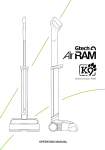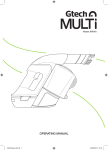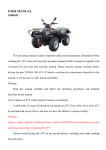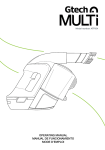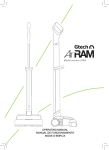Download Operating Instructions for Vibration Reduced Air Tools
Transcript
Operating Instructions for Vibration Reduced Air Tools HAVS Prolonged exposure to vibration when using paving breakers can cause damage to the hands and arms. This damage can take the form of hand arm vibration syndrome(HAVS) which affects the blood vessels, nerves , muscles and joints of the hands , wrists and arms. HAVS can become severely disabling if ignored and it’s best known form of vibration white finger (VWF), can be aggravated by cold or wet weather and can cause severe pain in the affected fingers. By using only vibration reduced Air Tools in accordance with the following recommendations you can substantially reduce your exposure to vibration and therefore the risk of contracting HAVS or VWF :- PERSONAL PROTECTIVE EQUIPMENT Always wear GLOVES, HEARING PROTECTION, GOGGLES AND STEEL TOECAPPED BOOTS when operating any Pneumatic Tool. If the application you are working on is likely to generate dust wear a face mask or wet the surface. Also wear a hard hat and suitable insulated waterproof and wind proof clothing to suit prevailing weather conditions.. Before using any Pneumatic Tool MANUFACTURERS INSTRUCTIONS read the SAFETY, OPERATING and MAINTENANCE INSTRUCTIONS supplied by the breaker manufacturer. Never exceed the maximum operating pressure recommended (7 bar). moil points narrow chisels SELECT THE CORRECT CUTTING TOOLS FOR THE JOB. Make sure any cutting tool you are about to use is sharp, not blunt, and is the correct length to enable you to adopt a comfortable stance when operating the Tool. Sometimes it is best to start with a shorter cutting tool, say 300mm below collar , then change to a longer one , say 450 or 500mm below collar as you move deeper below the work surface. Don’t use an asphalt or tarmac cutter when cutting concrete. Use only a moil point or narrow chisel ( see back page for recommended types of cutting tool). Always turn off the air supply and release the air in the hose before attempting to change a cutting tool. speedibust point tarmac cutter ( tapered tarmac cutter (flat) asphalt cutter - 5” Chisel end asphalt cutter - 3” Chisel end clay spade - straight digger steel - narrow digger steel - wide Moil Point Make sure any cutting tool you are about to use is sharp, not blunt. Blunt Sharp Asphalt Cutter Sharp Blunt Vibration Reduced Paving Breakers Correct Operation CORRECT PAVING BREAKER OPERATION Before depressing the throttle lever apply sufficient load to the paving breaker handles to move them to the HORIZONTAL position. This minimises “chisel bounce” during the first few seconds of running and is the correct handle position for all phases of paving breaker operation. HANDLES SHOULD BE HORIZONTAL If you overload the handles below the horizontal position you increase vibration. APPLY ONLY MINIMUM HANDLE GRIP FORCE Let the weight of the breaker do the work by providing the feed force to drive the cutting tool into the work surface. Except when working on a potential “break through” application, lay the hands flat on top of the breaker handles. If working on a “break through” application the fingers should be placed under the breaker hand grips ready to support the breaker and release the throttle as soon as “breakthrough” occurs. Do not grip the handles tightly. MOVE THE CUTTING TOOL OFTEN After the angled cutting faces of the cutting tool have entered the work surface the rate of cutting tool penetration of the work surface decreases substantially. Therefore, reduce vibration exposure by moving the cutting tool every 8 to 10 seconds. STOP THE BREAKER WHEN MOVING THE CUTTING TOOL POSITION The throttle should be released and the hands placed underneath the breaker handles (palms upward) when lifting the breaker to move the cutting tool position. palms upward MAKE SURE THE CUTTING TOOL DOES NOT BECOME JAMMED The main cause of jamming or sticking of the cutting tool especially in concrete surfaces is by trying to remove too large pieces of material in one go. Take smaller “bites”. Start by leaving approximately 75mm between successive cuts, the increase or decrease this distance to suit the material being cut. WHEN CUTTING CONCRETE Use a moil point or narrow chisel of the correct length to give a comfortable operating position. Remove the concrete in shallow layers ( approx. 75mm deep ) by moving the cutting tool after the angled cutting faces have penetrated the concrete (after 8 to 10 seconds of operation). Tilt the breaker slightly towards you, but make sure it does not touch any part of your body other than your hands . WHEN CUTTING ASPHALT OR TARMACADAM Use a straight bladed asphalt cutter rather than a curved blade. Try to keep the breaker as near vertical as possible during operation. Do not tilt the breaker except when using it as a lever to loosen pieces of Asphalt and only when the breaker is switched off. Try to keep the breaker as near vertical as possible during operation.
















